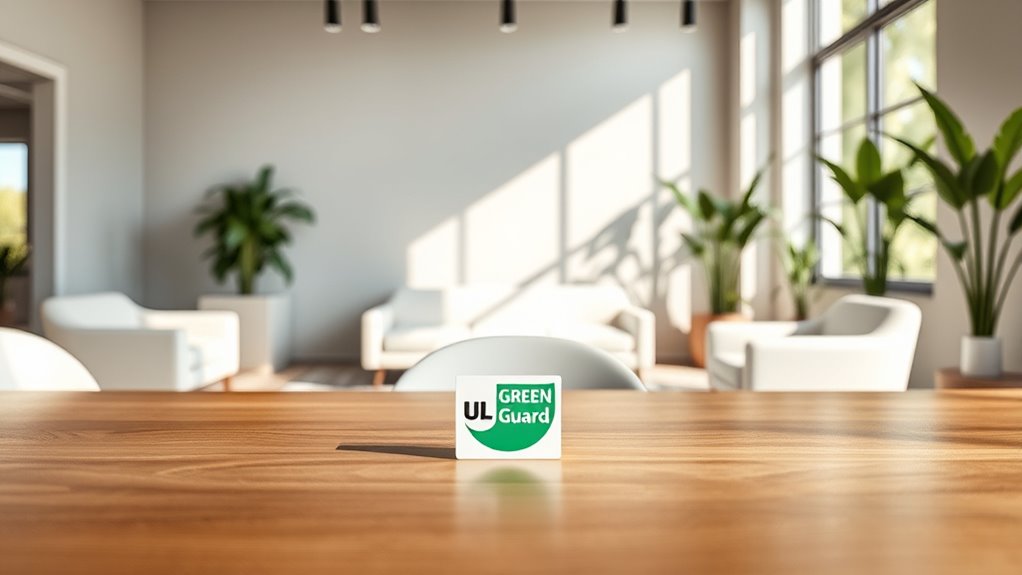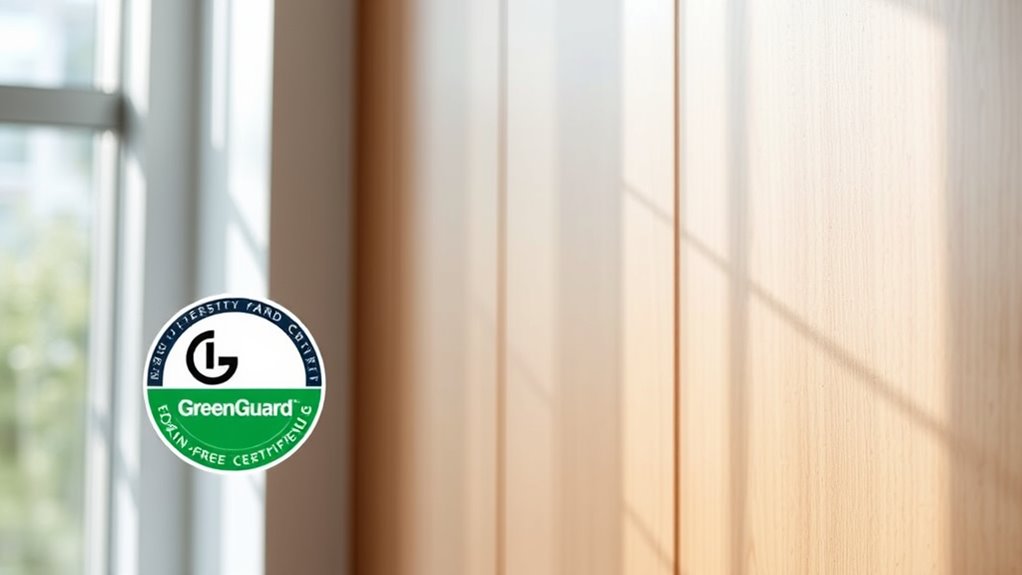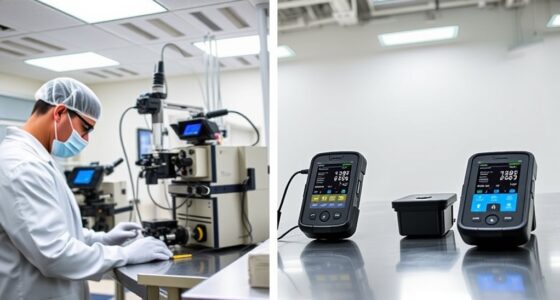UL GreenGuard certification guarantees that indoor products emit low levels of VOCs, helping you create a safer, healthier environment. It verifies that materials meet strict standards by testing for harmful chemicals like formaldehyde and benzene. Choosing GreenGuard-certified products reduces indoor air pollution and supports your well-being. This certification also highlights sustainable manufacturing practices, so you can feel confident about the safety and quality of your spaces. Keep exploring to learn how this certification makes a difference.
Key Takeaways
- UL GreenGuard certification verifies that products emit low levels of VOCs, ensuring healthier indoor air quality.
- Certified products undergo rigorous testing for chemicals like formaldehyde and benzene before approval.
- The certification promotes sustainable manufacturing practices and reduces the chemical footprint of indoor environments.
- GreenGuard standards help consumers select safer, environmentally responsible materials for homes and offices.
- Achieving GreenGuard certification indicates compliance with strict health and safety guidelines for low VOC emissions.

Have you ever wondered how to guarantee that the products you choose are safe for indoor environments? The answer lies in understanding certifications like UL GreenGuard, which focus on reducing chemical emissions and promoting better indoor air quality. When you select products with GreenGuard certification, you’re making a conscious choice to prioritize health and safety in your space. This certification ensures that the materials used in furniture, building materials, and other products meet strict standards for low chemical emissions, meaning fewer volatile organic compounds (VOCs) are released into your indoor air. VOCs are common pollutants that can cause health issues, especially in enclosed environments where air circulation is limited. By choosing GreenGuard-certified products, you actively reduce the risk of exposure to these harmful chemicals, creating a safer, healthier indoor atmosphere for everyone.
Understanding how chemical emissions impact indoor air quality helps you make smarter purchasing decisions. Many household and commercial products emit VOCs, including paints, adhesives, and furnishings. The problem is that these emissions can linger for weeks or even months after installation, gradually degrading the air you breathe. GreenGuard certification is designed to identify products that emit minimal levels of these chemicals, adhering to rigorous standards set by UL, a global safety certification organization. When a product bears the GreenGuard label, it means it has undergone thorough testing to measure its chemical emissions, including formaldehyde, benzene, and other toxic substances. This testing process ensures that the product is safe for indoor use and aligns with health guidelines. Additionally, the certification process considers the sustainability of manufacturing practices, ensuring environmentally responsible production.
Choosing GreenGuard-certified products allows you to create a healthier environment in your home or office. It’s especially important if you or your loved ones have sensitivities or respiratory issues. The certification helps you avoid products that could trigger allergies, asthma, or other health complications caused by poor indoor air quality. It also reassures you that the materials used are sustainably sourced and manufactured with low emissions, reducing the overall chemical footprint of your space. You don’t have to sacrifice quality or style to improve indoor air quality—many high-quality, attractive options carry the GreenGuard label, making it easier to select safe products without compromise.
Frequently Asked Questions
How Does UL Greenguard Certification Impact Product Pricing?
UL GreenGuard certification can increase product costs due to the rigorous testing and compliance requirements, impacting your overall cost implications. However, it often boosts market perception, making your products more attractive to eco-conscious consumers. While your initial prices might be higher, the certification helps differentiate your offerings, potentially leading to increased sales and customer loyalty, ultimately balancing out the higher costs with long-term benefits.
What Industries Most Commonly Seek UL Greenguard Certification?
If you’re considering UL GreenGuard certification, industries like furniture and building materials prioritize it to improve indoor air quality. For example, a manufacturer of office desks might seek certification to demonstrate their commitment to using sustainable materials and reducing VOC emissions. This helps them meet health standards and appeal to eco-conscious consumers. Overall, companies aiming for healthier indoor environments and sustainable products most commonly pursue UL GreenGuard certification.
Can Products Lose UL Greenguard Certification Over Time?
Yes, your product can lose UL GreenGuard certification over time if it no longer meets the certification standards. You need to maintain product certification by undergoing periodic testing and certification renewal, ensuring ongoing compliance with low VOC emissions. If your product’s formulation or manufacturing processes change and result in higher emissions, it may no longer qualify, so regular checks and updates are essential to keep the certification valid.
How Long Does the Certification Process Typically Take?
Think of the certification process like planting a seed—patience helps it cultivate. Typically, the certification timeline spans 4 to 8 weeks, depending on product complexity. The testing duration involves rigorous assessments to ensure low VOC emissions. During this period, your product undergoes various tests, and delays can happen if additional data or retesting is needed. Stay proactive, and you’ll see your product certified in no time.
Are There Any Regional Differences in Certification Standards?
Yes, there are regional variations in certification standards, which can influence your certification process. International standards often set the baseline, but specific regions like North America, Europe, or Asia might have additional requirements or stricter limits for low VOC emissions. You should check local regulations and standards to verify your products meet all regional variations, helping you achieve certification smoothly and expand your market reach confidently.
Conclusion
By choosing UL GreenGuard certified products, you prioritize healthier indoor environments. Imagine a school that switches to GreenGuard-certified furniture; students and staff breathe easier with reduced VOC emissions. This commitment not only safeguards health but also enhances overall well-being. You can confidently create spaces that are safer and more sustainable, knowing these products meet strict standards. Ultimately, UL GreenGuard certification empowers you to make informed, responsible choices for a cleaner, healthier future.










